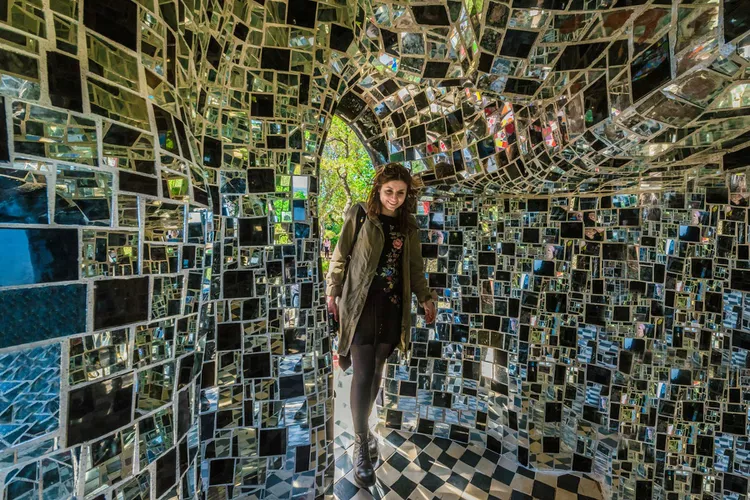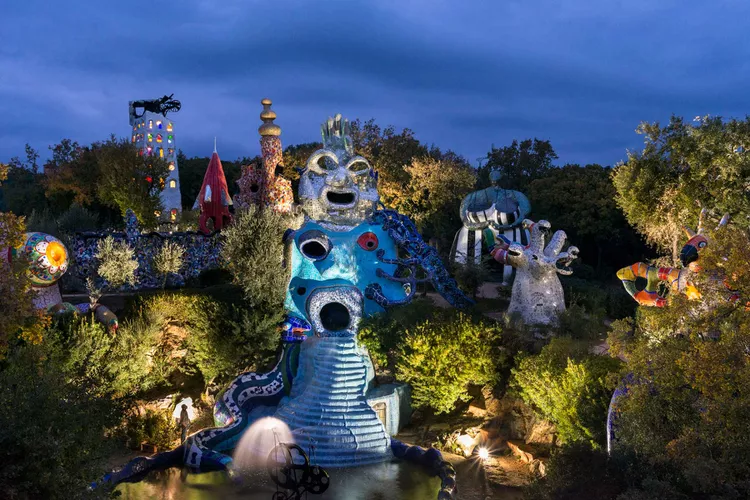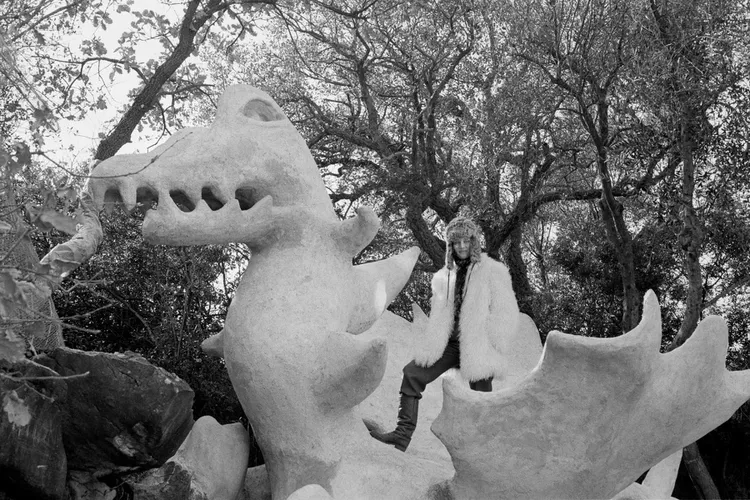The location is the masterpiece that Niki de Saint Phalli created throughout her entire career.
We finally spotted the tips of the sculptures on a hilltop outside of Garavicchio, which is a mediaeval village in southern Tuscany. The drive from Florence took us two and a half hours. My attention was drawn to glints of blue, green, white, and red caused by the sun reflecting off of the mirrored tiles. As we made our way up the road, I found myself holding my breath. After reading so much about Niki de Saint Phalle's tarot garden, the idea that I would actually get to see it in person felt just as incredible as the notion that the garden even existed.
The purpose of tarot cards is not to provide insight into the future but rather to offer imagery that can silently and subtly plant seeds in the subconscious. It's possible that this is why the symbology of a tarot card has always retained such a strong appeal for artists. The surrealists Leonora Carrington and Salvador Dal both produced their own decks of tarot cards; the printmaker Betye Saar included tarot cards (such as the star and the moon) into some of her earliest and most significant works; and the director Agnès Varda is famous for beginning her film Cléo from 5 to 7 with a tarot reading. However, Saint Phalle outdid all of them by lifting the figures off of the cards and placing them in the real world.
The French-American artist had a dream that inspired her to create the project, which was inaugurated in 1998 on an old Etruscan site. In the dream, she envisioned creating a sculpture garden in the shape of a tarot deck. According to what she wrote, "if life is a game of cards, we are born without knowing the rules." But we have to play the hand we've been dealt."
Saint Phalle, along with a group of artists, electricians, and passionate locals (including a postman), began constructing sculptures on land that belonged to the aristocratic Caracciolo family in 1978. These pieces were inspired by the 22 major arcana. All of the tiles were handcrafted and heated locally, and they were glazed in primary colors, wacky jewel tones, and cartoon pinks, oranges, and yellows. The merry gang that worked for Saint Phalle constructed iron frames, then covered them in cement, and finally sheathed them in tiles. Still others had been covered in tiny mirrors, which reflected the sky and caused it to crack. Saint Phalle was stricken with rheumatoid arthritis towards the end of her life and could hardly move because of it; despite this, she never stopped daydreaming of new ways to improve her garden. She was in the process of planning a maze when she passed away in the year 2002. She referred to the garden as "my husband, my love, my everything" in one of her writings.

Her sculptures make allusions to the sinuous mosaics in Antonio Gaud's Parc Güell in Barcelona, as well as to the 16th-century Gardens of Bomarzo, which are located in northern Lazio; the Ideal Palace, which is a fantastical castle built by postal worker Ferdinand Cheval in Hauterives, France; the Alhambra in Granada, Spain; Mayan ruins located throughout Mexico; and Russian Orthodox churches. She produced the illustrations based on the Marseille tarot, which is regarded to be the oldest deck still in existence, as well as the Rider-Waite Smith deck, which is used by a greater number of people. However, she also created works freely based on her own imagination. The end product is a collection of creatures from a carnival that have been grouped in an otherwise ordinary Tuscan landscape in a way that is both weird and gigantic.
Tarot Garden is a sculpture garden based on the esoteric tarot, created by the French-American artist Niki de Saint Phalle in Pescia Fiorentina, località Garavicchio, in the municipality of Capalbio, province of Grosseto, Tuscany, Italy. The park was opened to the public in 1998. pic.twitter.com/P4s69YpFx6
— Archaeo - Histories (@archeohistories) October 18, 2021
Saint Phalle attempted to include references to as many different cultures and religions from around the world as she could on the surfaces of her sculptures. Egyptian, Mesopotamian, Kabbalah, and Christian references can be found among them. Monsters and other prehistoric creatures often make an appearance as metaphors for the return of an ancient power. They are designed to be interacted with in a variety of ways, including being caressed, climbed on, and played with in other ways. Because of this, my boyfriend Ben and I believed that taking our son Julien, who is three years old, on a trip to the garden would be a fun thing for him to do. However, once we passed through the gate, he walked ahead of us and sat down on the gravel path, his attention focused on the shards of rock rather than the mosaics that the rest of the people had come to see. He was engaging in his own version of freedom, something that Saint Phalle would have no doubt approved of. I went up into the park by myself while Ben remained with the other man.
When I walked in, I was met with The Magician and the High Priestess, out of whose mouth gushed a massive fountain. At the same time, the Wheel of Fortune, a kinetic mechanism constructed by Saint Phalle's spouse, the Swiss sculptor Jean Tinguely, swirled water around in all different directions. According to Rachel Pollack, an authority on tarot, these two different cards in the deck reflect "archetypal male/female energies." Rachel Pollack is a tarot card reader. Saint Phalle was making a statement about moving past those distinctions when she combined the two statues into a one work of art. She posed the question, "What can we do if we bring energies together?" Strength is on the side of the magician and depicts a woman with fiery hair who challenges a dragon with a red pedicure. the dragon has green and spangled scales. His wings are covered in a pattern of flaming red, yellow, and orange tiles. Her right hand is lifted, suggesting that she is about to either battle the dragon or pet him.

As I climbed a set of numbered steps, I came face to face with Justice, which Niki de Saint Phalle had portrayed as a voluptuous woman in black and white, with scales for breasts. Within the dungeon-like womb of Justice, another machine-like Tinguely installation called Injustice creaked away behind an iron gate. After that, I became distracted for a moment as I stared at the prismatic Tree of Life and everything that was written on its trunk. There were elaborate designs, phrases written in a variety of languages, and enigmatic number patterns. My first impression was that if it could only be deciphered, it might hold the secret to understanding all legends.
At that very moment, I received a picture in the form of a text message from Ben showing Julien going up and down a set of numbered steps. My spirits were raised. It turned out that bringing him to this location was not such a bad idea after all. I came across The World, a sculpture by Tinguely in which a woman delicately balances on one foot over a golden egg that is surrounded by a colourful snake. The egg itself is placed on a Tinguely sculpture. The egg spins around, creating a reflective effect similar to that of a disco ball all over the yard. This gives the impression that the egg is enclosing itself in some kind of force field.
https://utravelo.com/en/activities-in-athens-georgia
I made my way into the enormous edifice known as the blue-haired Empress/Sphinx, which was about the size of a modest house and served as Saint Phalle's home for a portion of the time the garden was being constructed. The gigantic statue's left breast can accommodate a whole kitchen, while the right breast can accommodate a bedroom. It is possible to get a view of the surrounding area, including the garden and the landscape beyond it, through the portholes in the nipples. Even the dishwasher is fully coated in bits of mirror that have been scattered throughout the interior.
Because tarot card decks are designed to be reshuffled after each use, the meanings of the cards might shift depending on how they are drawn and where they are put in the spread. The only thing that shifts is the path that people take around the park and the sequence in which they see the many statues; in Saint Phalle's three-dimensional deck, they are permanently installed. Their "readings" are actually just long walks about the neighbourhood.

My own journey through the cards was defined in part by the responsibilities I had as a journalist, and in part by the obligations I had as a family member. I know that Saint Phalle struggled with the conflicting demands of her job and her personal life because she spoke about it in letters to her friends. I conjured up her spirit while I lingered within the belly of the Empress, photographing the mirrored mosaics and giving myself a little bit of extra time to study the environment for myself before I went back to observing it for my child.
When I pondered about the situation, I reflected on the cards that I had been dealt, so to speak: Strength, the Tree of Life, the World, and the Empress. I'm not totally certain that I have completely taken in all of their imagery with my conscious mind, but on the other hand, it makes me glad to think that perhaps I'm not intended to, and that they can continue to work on my subconscious all by themselves until I can come back.

